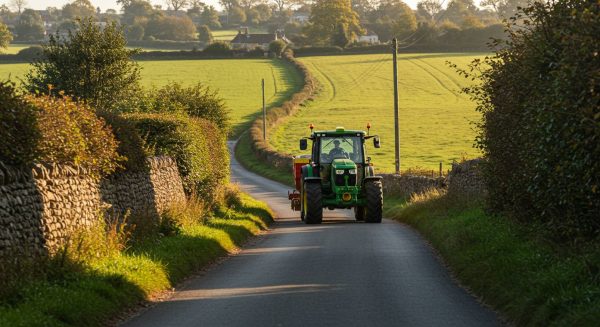To operate self-propelled agricultural equipment in the UK (i.e. most agricultural vehicles with engines), operators must hold the appropriate licence category. For most agricultural tractors, a category F license is required, which is automatically included when passing a standard car driving test (category B). However, there are important age restrictions to consider. According to the Driver and Vehicle Licensing Agency (DVLA), 16-year-olds may only drive tractors up to 2.45 meters wide and must tow trailers no wider than 2.45 meters with either two wheels or four close-coupled wheels. From age 17, these width restrictions no longer apply.
For other self-propelled equipment like combine harvesters and sprayers, operators must be at least 17 years old to drive vehicles up to 3.5 tonnes, 18 years old for vehicles between 3.5 and 7.5 tonnes, and 21 years old for vehicles over 7.5 tonnes.
Vehicle Requirements and Road Safety
When operating self-propelled agricultural equipment on public roads, several key requirements must be met. The Department for Transport guidance specifies that vehicles must not exceed 3 meters in width without special notification. For vehicles between 3-3.5 meters wide, if the journey is over 5 miles or involves travelling through a 40 mph zone, the police must be notified two days in advance, and the vehicle must display “wide load” signs and use a warning beacon.
For telehandlers and equipment with front-mounted attachments, the Health and Safety Executive (HSE) advises that when travelling on public highways, forks or other attachments should either be removed and transported separately, folded back and secured, or covered with an appropriate guard. This prevents dangerous projections that could risk other road users.
Speed Restrictions and Road Conduct
Most agricultural vehicles are restricted to 25 mph on public roads unless they meet specific higher-speed requirements. These requirements include having all-wheel suspension, adequate braking efficiency, pneumatic tyres, and a functioning speedometer. The Road Vehicles (Construction and Use) Regulations specify that agricultural vehicles must have braking efficiency of at least 25% when fully loaded.
When driving on public roads, operators should be mindful of other road users and avoid creating long queues of traffic that can lead to dangerous overtaking attempts by frustrated drivers. If there’s a build-up of traffic behind your vehicle, pull over to make it easier for them to pass.

Maintenance and Equipment Checks
Under the Provision and Use of Work Equipment Regulations (PUWER), all self-propelled agricultural equipment must be maintained in a safe condition. Before operating on public roads, operators should check:
- All lights and indicators are functioning properly.
- Mirrors are correctly adjusted and clean.
- The tyres are in good condition with no significant cuts or bulges.
- Brakes are working effectively.
- The vehicle is clean enough to prevent depositing mud or debris on the road.
Special Considerations for Poor Visibility
During hours of darkness or poor visibility, agricultural vehicles must be properly illuminated. The DVLA requires that vehicles first used after January 1996 and capable of speeds over 25 mph must be equipped with main-beam headlamps, dipped-beam headlamps, direction indicators, hazard warning lights, rear fog lamps, and stop lamps. An amber warning beacon is mandatory when travelling on unrestricted dual carriageways at speeds under 25 mph.
Environmental and Safety Responsibilities
Operators must ensure their equipment doesn’t pose environmental hazards. The guidance from the Northern Ireland Environment Agency emphasises the importance of preventing spillages and maintaining clean roads. If mud or other materials are deposited on the road, operators have a legal responsibility to clean it up promptly to prevent hazards to other road users.
Remember that while agricultural vehicles enjoy certain exemptions from standard vehicle regulations, these only apply when the vehicle is being used for genuine agricultural, horticultural, or forestry purposes. Using agricultural vehicles for other purposes may invalidate these exemptions and require compliance with standard vehicle regulations.
